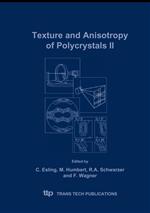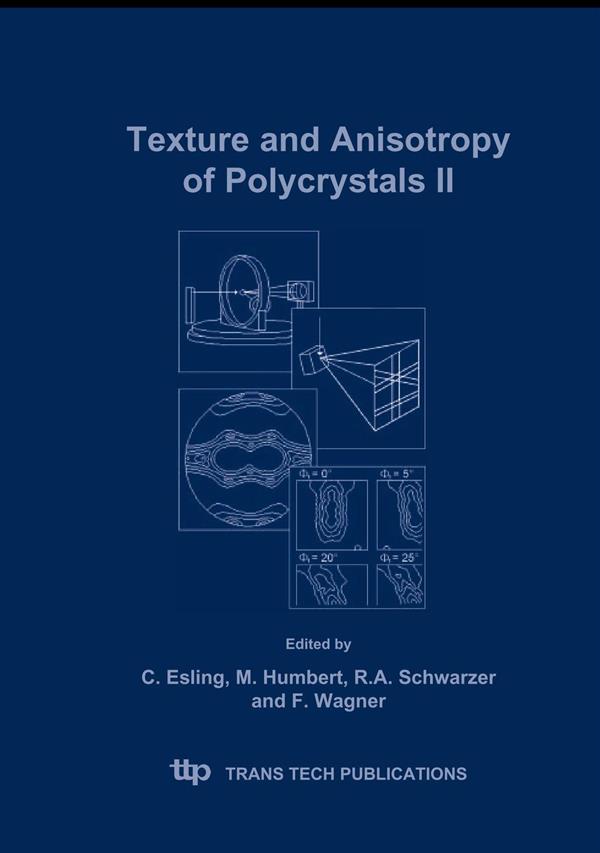Engineering Research
Advanced Engineering Forum
Applied Mechanics and Materials
Engineering Chemistry
Engineering Innovations
Journal of Biomimetics, Biomaterials and Biomedical Engineering
International Journal of Engineering Research in Africa
Materials Science
Advanced Materials Research
Defect and Diffusion Forum
Diffusion Foundations and Materials Applications
Journal of Metastable and Nanocrystalline Materials
Journal of Nano Research
Key Engineering Materials
Materials Science Forum
Nano Hybrids and Composites
Solid State Phenomena
Engineering Series
Advances in Science and Technology
Construction Technologies and Architecture
Engineering Headway
Texture and Anisotropy of Polycrystals II
Subtitle:
ITAP 2
Description:
Volume is indexed by Thomson Reuters CPCI-S (WoS).
Natural, as well as man-made, materials are often assumed to behave uniformly, exhibiting equal strength in all directions, because most of them have a polycrystalline structure. The anisotropy of the individual crystals, however, is smoothed out only in the presence of a large number of grains having a random distribution of orientations. In reality, there usually remains an anisotropy due to the existence of preferred orientations. Its magnitude depends upon the statistical distribution of grain orientations – the "crystallographic texture" or, more simply, the texture. –This governs the extremes, of the physical property of interest, which a single crystal of the material under consideration can exhibit in directional tests. Local variations in texture, as well as the arrangements and types of grain/phase boundaries, may give rise to inhomogeneous material properties. The texture also carries with it information on the history of a material’s processing, use and misuse. A knowledge of the texture is a prerequisite for all quantitative techniques of materials characterization, and is based upon the interpretation of diffraction-peak intensities. It is also necessary to model the relationships between microstructural features and physical or mechanical properties. Therefore, the texture is of great value for quality control in a wide range of industrial applications, and in basic materials research.
Natural, as well as man-made, materials are often assumed to behave uniformly, exhibiting equal strength in all directions, because most of them have a polycrystalline structure. The anisotropy of the individual crystals, however, is smoothed out only in the presence of a large number of grains having a random distribution of orientations. In reality, there usually remains an anisotropy due to the existence of preferred orientations. Its magnitude depends upon the statistical distribution of grain orientations – the "crystallographic texture" or, more simply, the texture. –This governs the extremes, of the physical property of interest, which a single crystal of the material under consideration can exhibit in directional tests. Local variations in texture, as well as the arrangements and types of grain/phase boundaries, may give rise to inhomogeneous material properties. The texture also carries with it information on the history of a material’s processing, use and misuse. A knowledge of the texture is a prerequisite for all quantitative techniques of materials characterization, and is based upon the interpretation of diffraction-peak intensities. It is also necessary to model the relationships between microstructural features and physical or mechanical properties. Therefore, the texture is of great value for quality control in a wide range of industrial applications, and in basic materials research.
Purchase this book:
eBook
978-3-03813-026-0
$198.00 *
Print
978-3-908451-09-9
$319.00
not available
eBook+Print
978-3-908451-09-9
$413.60 *
not available
* 1-User Access (Single User-Price). For Multi-User-Price please fill a contact form
Info:
eBook:
ToC:
Editors:
C. Esling, M. Humbert, R.A. Schwarzer and F. Wagner
DOI:
https://doi.org/10.4028/b-2cNCw0
DOI link
THEMA:
TGM
BISAC:
TEC021000
Keywords:
Details:
Proceedings of the International Conference on Texture and Anisotropy of Polycrystals (ITAP 2)
Pages:
486
Year:
2005
ISBN-13 (softcover):
9783908451099
ISBN-13 (CD):
9783035719789
ISBN-13 (eBook):
9783038130260
Permissions CCC:
Permissions PLS:
Share:

